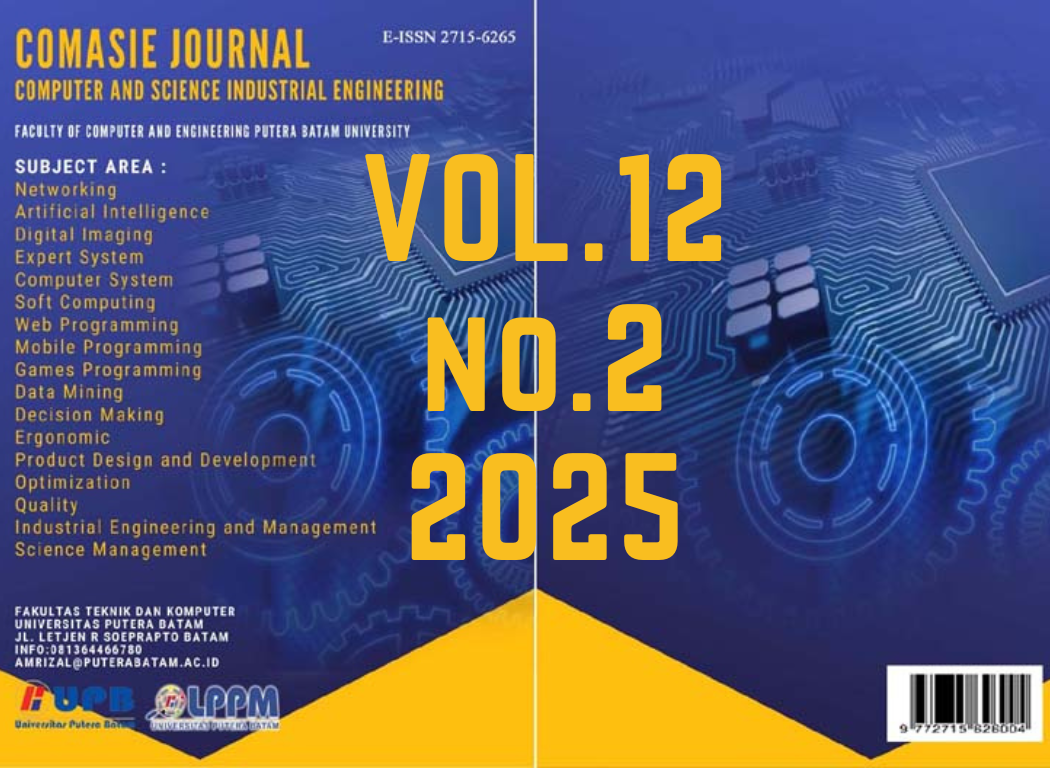ANALISIS PERBANDINGAN KINERJA ALGORITMA MACHINE LEARNING BERBASIS FEATURE SELECTION DALAM DETEKSI SERANGAN BOTNET
DOI:
https://doi.org/10.33884/comasiejournal.v12i2.9778Keywords:
Botnet, Dataset, Feature Selection, K-Nearest Neigbors, Machine Learning, Naive Bayes, Support Vector MachineAbstract
Internet has experienced significant development. Increasing devices connected to internet makes security against cyber attacks a critical issue, thus creates opportunities for cyber attackers, one form of those attack is botnets. In Indonesia, Botnets is the highest traffic anomalies in 2022 by BSSN. High number of attacks because detecting botnet can be challenging, difficulty of detecting attacks and low level of detection accuracy means that normal data sometimes considered an attack, so choosing method that can handle this is very important. Machine learning algorithms are able to study network data traffic and identify suspicious activity, this makes machine learning an effective method. Machine learning based on feature selection has an accuracy of above 90% in detecting DDoS attacks on datasets and machine learning algorithms are also able to detect attack data and normal data. Thus, in this research machine learning algorithms such as K-Nearest Neighbors, Support Vector Machine and Naive Bayes will be applied to dataset containing botnet and normal data to explore how machine learning algorithms can effectively detect botnet attack patterns and normal data. This research compares the performance of commonly used machine learning algorithms to find which one effective for detecting botnet attacks in existing datasets.
References
Agustina, V., & Saraswati, S. (2024). Implementasi Metode Naïve Bayes Classifier Dalam Analisis Sentimen Opini Publik Twitter Tentang G20 Indonesia.
Azis, H., Purnawansyah, P., Fattah, F., & Putri, I. P. (2020). Performa Klasifikasi K-NN dan Cross Validation Pada Data Pasien Pengidap Penyakit Jantung. ILKOM Jurnal Ilmiah, 12(2), 81–86. https://doi.org/10.33096/ilkom.v12i2.507.81-86
Darryl, P., & Subali, M. (2021). Perbandingan Algoritma SVM dan Algoritma KNN Dalam Menghasilkan Klasifikasi DDoS dan Benign. Jurnal Ilmiah KOMPUTASI.
Maslan, A., Mohamad, K. M. Bin, & Mohd Foozy, F. B. (2020). Feature selection for DDoS detection using classification machine learning techniques. IAES International Journal of Artificial Intelligence, 9(1), 137–145. https://doi.org/10.11591/ijai.v9.i1.pp137-145
Mesri Silalahi, & Saut Pintubipar Saragih. (2021). Perancangan Website Penyedia Informasi Promosi dan Diskon. JUSTIN (Jurnal Sistem Dan Teknologi Informasi), 9(2), 257–262. https://jurnal.untan.ac.id/index.php/justin/article/view/43463/75676589335
Saragih, S. P. T. I., & Harisno, H. (2015). Influence Of Knowledge Sharing and Information Technology Innovation on Employees Performance at Batamindo Industrial Park. CommIT (Communication and Information Technology) Journal, 9(2), 45. https://doi.org/10.21512/commit.v9i2.1657
Moorthy, R. S. S., & Nathiya, N. (2022). Botnet Detection Using Artificial Intelligence. Procedia Computer Science, 218, 1405–1413. https://doi.org/10.1016/j.procs.2023.01.119
Muawanah, S., Muzayanah, U., Pandin, M. G. R., Alam, M. D. S., & Trisnaningtyas, J. P. N. (2023). Stress and Coping Strategies of Madrasah’s Teachers on Applying Distance Learning During COVID-19 Pandemic in Indonesia. Qubahan Academic Journal, 3(4), 206–218. https://doi.org/10.48161/Issn.2709-8206
Pratiwi, N., & Setyawan, Y. (2021). ANALISIS AKURASI DARI PERBEDAAN FUNGSI KERNEL DAN COST PADA SUPPORT VECTOR MACHINE STUDI KASUS KLASIFIKASI CURAH HUJAN DI JAKARTA. Journal of Fundamental Mathematics and Applications (JFMA), 4(2), 203–212. https://doi.org/10.14710/jfma.v4i2.11691
Rostami, M., Berahmand, K., & Forouzandeh, S. (2022). Review of Swarm Intelligence-based Feature Selection Methods.
Sharifani, K., & Amini, M. (2023). Machine Learning and Deep Learning: A Review of Methods and Applications. In World Information Technology and Engineering Journal (Vol. 10). https://ssrn.com/abstract=4458723
Suyal, M., & Goyal, P. (2022). A Review on Analysis of K-Nearest Neighbor Classification Machine Learning Algorithms based on Supervised Learning. In International Journal of Engineering Trends and Technology (Vol. 70, Issue 7, pp. 43–48). Seventh Sense Research Group. https://doi.org/10.14445/22315381/IJETT-V70I7P205
Viet, T. N., Minh, H. Le, Hieu, L. C., & Anh, T. H. (2021). The naÏve bayes algorithm for learning data analytics. Indian Journal of Computer Science and Engineering, 12(4), 1038–1043. https://doi.org/10.21817/indjcse/2021/v12i4/211204191
Xing, Y., Shu, H., Zhao, H., Li, D., & Guo, L. (2021). Survey on Botnet Detection Techniques: Classification, Methods, and Evaluation. In Mathematical Problems in Engineering (Vol. 2021). Hindawi Limited. https://doi.org/10.1155/2021/6640499














